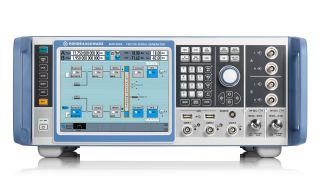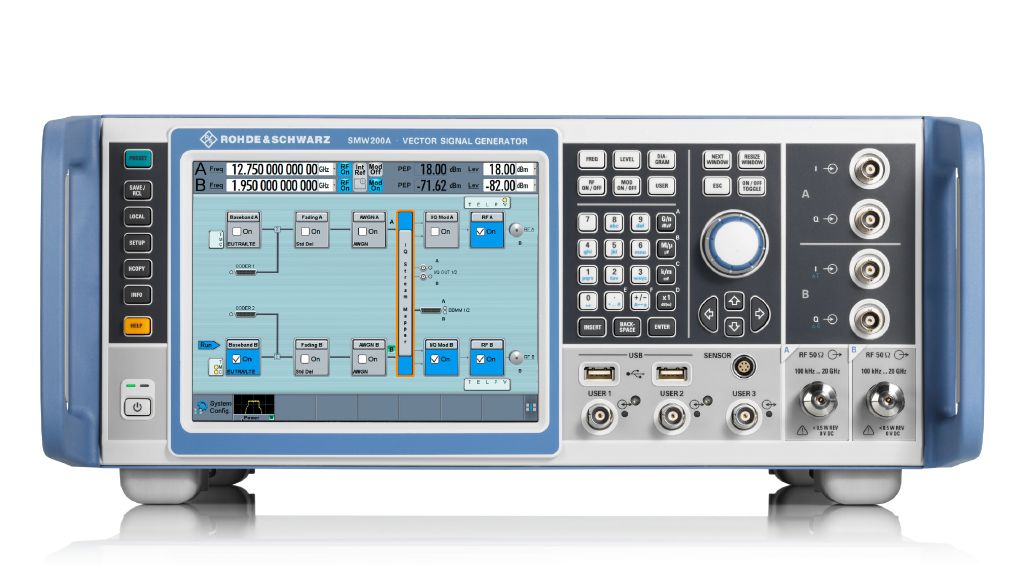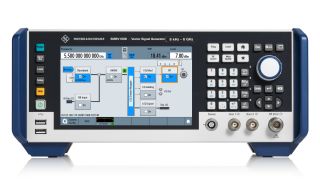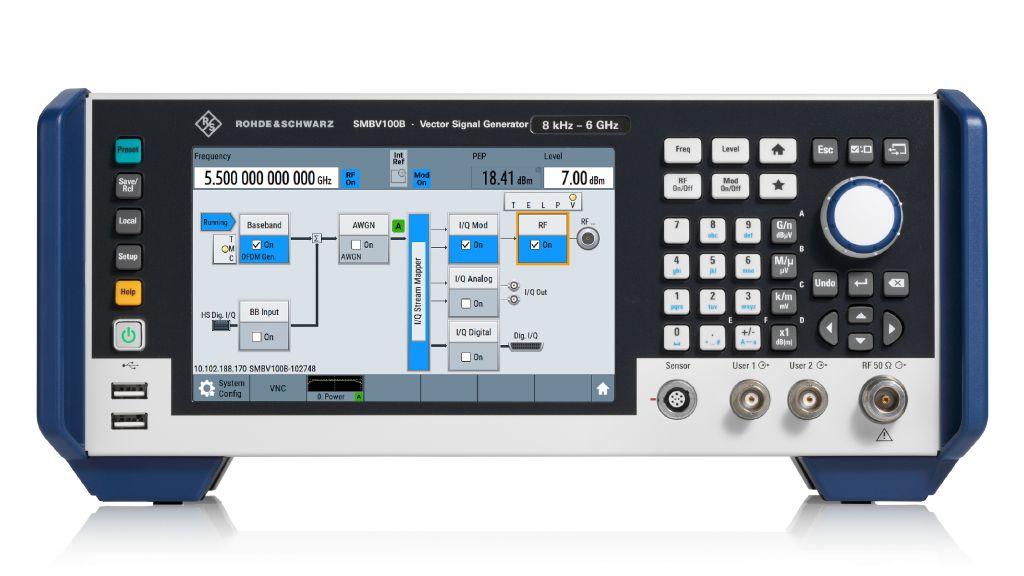5G aus dem Weltraum – Konsequenzen für die NTN-Messtechnik
Autor: Reiner Stuhlfauth, Technology Manager

Autor: Reiner Stuhlfauth, Technology Manager
Die Mobilfunkbranche steht vor einem Paradigmenwechsel: Denn das Konzept einer „Basisstation“ ist im Kontext nicht-terrestrischer Netze (NTN) obsolet. Stattdessen werden Netzknoten in Satelliten integriert und bewegen sich folglich relativ zur Erdoberfläche. Langfristig – also für 6G – sollen Multi-Orbit-Netze mit einer 3-dimensionalen Netzknoten-Architektur entstehen, die sämtliche LEO-, MEO- und GEO-Umlaufbahnen umfasst.
Verschiedene Konzepte für diese Architektur befinden sich derzeit im Standardisierungsverfahren:
Derzeit liegen zwei Dokumente mit Vorschlägen für Standardisierungsanforderungen vor, die für zukünftige SAN-Tests wichtig sein werden:
Bild 1 unten zeigt eine kurze Übersicht über Testszenarien und einen symbolischen Messaufbau für einen SAN, der im NTN-Modus für transparente Nutzlasten arbeitet. Das Messobjekt (DUT) umfasst drei Funktionsblöcke: den Satelliten (im Bild als NTN Payload RF bezeichnet), das Gateway und die NTN-unabhängigen Netzwerkfunktionen (gNB).


Bild 1: Testszenarien für den transparenten NTN-Modus
Die HF-Schnittstellentests können grob unterteilt werden in:
Bei den Tests am Sender wird ein ähnlicher Ansatz verfolgt wie im terrestrischen Fall, mit Kennzahlen wie Sendeleistung (TX Power, TX Power Control), Modulationsqualität (EVM) und spektralen Sendeeigenschaften (ACLR, Störstrahlungen, SEM). Ein Signalanalysator ist hierfür das ideale Messgerät. Je nach Kategorie des Satellitenknotens kann die Verbindung zum Testgerät über eine kabelgebundene Verbindung oder Over-The-Air (OTA) hergestellt werden. OTA-Tests ermöglichen die Verifizierung von Richtantennen, die für die Strahlformung eingesetzt werden. Diese Art von Test erfordert eine vollabsorbierende Schirmkammer (FAC) sowie einen Drehstand.
Für Empfängertests sind zwei verschiedene Ansätze verfügbar:
Grundsätzlich gelten bei Endgeräten für die 5G-Satellitenkommunikation die gleichen Anforderungen an Sender und Empfänger wie im Fall terrestrischer Netze. Der Teufel steckt jedoch im Detail: Es gibt verschiedene Testaufbauten und -verfahren, je nach Funktionalität des NTN-Endgeräts und Anwendungsfall. Beispielweise wird die Gerätekategorie NTN-IoT eine Architektur mit geringer Komplexität verwenden.
Darüber hinaus erfordern Anwendungsfälle wie Messaging oder kleine Datensätze normalerweise kein bestimmtes QoS-Profil und sind sehr verzögerungstolerant. Künftige NTN-Endgeräte, z. B. VSAT-Terminals (Very Small Aperture Terminals), werden anspruchsvollere Technologien wie Beamforming, höhere Frequenzen und größere Bandbreiten nutzen. Hierfür werden umfassendere Tests notwendig. Das Frequenzspektrum ist für NTNs von entscheidender Bedeutung, da es zahlreiche mögliche Konfigurationen gibt: NTN-Bänder können sich etwa mit terrestrischen Bändern überlappen, unmittelbar nebeneinander liegen oder über einen ausreichenden Sicherheitsabstand verfügen. Daher sollte die Testkampagne auch einige Koexistenzszenarien abdecken.
3GPP arbeitet an der Erweiterung der Endgeräteanforderungen für die Satellitenkommunikation. Die entsprechende Spezifikation trägt die Bezeichnung TS 38.101-5. Dieses Dokument gehört zur Endgeräte-Spezifikationsserie TS 38.101-x und deckt verschiedene NTN-Aspekte mit den zugehörigen Kennzahlen ab:
Für angemessene Endgerätetests ist ein Systemsimulator erforderlich, der Verbindungen handhaben kann, die den gesamten Protokollstapel umfassen, und HF-Tests sowie Protokolltests ermöglicht. Bild 2 zeigt einen entsprechenden Messaufbau im Überblick. Das Endgerät, das den Prüfling darstellt, ist über Kabel mit dem Systemsimulator verbunden oder befindet sich in einer OTA-Kammer. Dieser Systemsimulator führt sowohl HF- als auch Protokolltests durch. Die Protokolltests sind dabei besonders wichtig für die Prüfung von Verbindungs- und Mobilitätsszenarien.


Bild 2: Systemsimulator, der Protokolltests unterstützt
Eine Anforderung an NTN-Terminals ist die terrestrische Positionsbestimmung. Daher gehört die Positionsbestimmung anhand von GNSS-Signalen zur obligatorischen Funktionalität von NTN-Endgeräten. Die Satellitenstation sendet ihre eigenen Bahndaten über Systeminformationen und unterstützt das Endgerät bei der Korrektur des Zeitversatzes und der Dopplerverschiebung.
In einem NTN-Testsystem für Konformitätsprüfungen kann ein Signalgenerator das GNSS-Signal simulieren, um dem Endgerät die Positionsbestimmung zu ermöglichen. Darüber hinaus erfordern die Typgenehmigung und regulatorische Tests erweiterte Spektralmessungen, wie etwa Tests der Störaussendungen und Empfangsleistung. Der 5G-Systemsimulator kann zusätzliche Messgeräte wie Signalgeneratoren und -analysatoren umfassen, um solche zusätzliche Störszenarien oder erweiterte Spektrumanalysen abzudecken.
Der R&S®CMX500 Mobilfunktester unterstützt vollständig unabhängige LTE/FR1- und FR2-HF-Signalisierungs- und -Messoptionen sowie alle aktuellen und zukünftigen 3GPP-Bandkombinationen mit einem Datendurchsatz von bis zu 20 Gbps auf IP-Ebene. Er folgt der One-Platform-Strategie von Rohde & Schwarz – mit Gesamtfrequenzbandbreiten von bis zu 10 GHz rüstet er den Benutzer für aktuelle und zukünftige Testherausforderungen. Dank der intuitiven, webbasierten grafischen Benutzeroberfläche R&S®CMsquares setzt dieser One-Box-Tester den neuen Standard für 5G-NTN-Tests.


Hauptmerkmale:


Hauptmerkmale:
Fazit
Sie haben Fragen? Kontaktieren Sie uns gern.